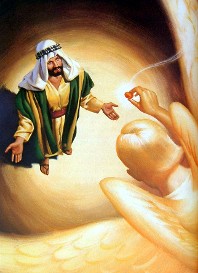Most Seventh-day Adventists feel they know just about all there is to know about the Day of Atonement, or Yom Kippur, that yearly festival, described so solemnly in Leviticus. But as Adventists, we’ve somewhat lost our grasp of the meaning and symbols portrayed there, and this week’s lesson gets us back on the right track.
As you may have observed, Hebrew literature places the most valuable information in the center of a passage. Therefore we aren’t surprised that the best description of the earthly Day of Atonement is not only in the middle of Leviticus, in chapter 16, but the book of Leviticus itself actually falls in the middle of the Pentateuch, or the first five books of Moses in our Bible. This should emphasize to us the importance of the ritual, above all others.
Memory Text: “Who is a God like Thee, who pardons iniquity and passes over the rebellious act of the remnant of His possession? He does not retain His anger forever, because He delights in unchanging love. He will again have compassion on us; He will tread our iniquities underfoot. Yes, thou wilt cast all their sin into the depths of the sea.” Micah 7:18, 19 NASB
The loveliness of this text is the promise that God will someday put an end to all sin. All sins will be as if they were cast into the ocean depths. Forgiveness and repentance will no longer be needed (“He does not retain His anger [righteous indignation] forever”), because sin will be eradicated from the universe, and love will reign for all eternity (“He delights in unchanging love).
These gospel truths are illustrated most graphically in the sanctuary ritual of the Day of Atonement, the final festival of the year. Leviticus 16:31 calls it a Sabbath of solemn rest, or you could say a Sabbath of Sabbaths. This unique feature points to it as a time of resting in what God has done for us as Creator AND Redeemer.
Seeing the enactment of the ceremony with the two goats, properly understood, helps us understand more deeply what will occur on that great future Day of Atonement.
Discussion Questions: Why is the understanding of Leviticus 16 so central to our understanding the plan of salvation? Does the fact that the Day of Atonement was the holiest day of the year, when the holiest person in all Israel went into the holiest place on earth to perform the holiest work of all, make it more significant and worthy of our study? Describe how these events run parallel with the antitypical Day of Atonement that is occurring in the heavenly sanctuary in these end times.
Sunday: The Yearly Cleansing
As we saw last week, throughout the year, sacrifices were made for forgiveness of sins and they were transferred solemnly to the sanctuary edifice itself through the priest, or mediator of the people. On this Day of Atonement, only the High Priest officiates, and it is the only time in the year that he makes an entrance into the Most Holy Place.
The three rituals consisted of:
- A purification offering for the priest–after all, he must have his sins transferred to a bull, before he can continue the ceremony, which will take him directly into the presence of God before the Mercy Seat
- A purification offering of the goat “for the Lord”–this goat was slain, but had no sins transferred to it by the laying on of hands, thus signifying the death of the sinless Christ as its antitype
- An elimination ritual–a scapegoat, chosen by lots, had all the sins of the sanctuary transferred to it, and then the animal was cast outside the camp to die in the wilderness, a fitting symbol of the fate of Satan, who bears the responsibility for sin
Only on this Day of Atonement could it be said that the people and the sanctuary were both cleansed. The first phase occurred all through the year as the Israelites came for forgiveness and had their sins transferred to the sanctuary.
The second phase that happened on the Day of Atonement wasn’t about forgiveness at all, but about cleansing. This reminds us that the plan of salvation in its widest context is more than about forgiveness.
Sin, and the need for forgiveness, will someday have an end. The whole universe will be “cleansed” at the end of time, as was the earthly sanctuary at the end of the year.
Discussion Questions: How would you take the sting out of the Day of Atonement? Why does it feel more like a dreaded Day of Judgment? And how can we change this perception? What does the word “atonement” signify?
Monday: Beyond Forgiveness
All year, the priests worked with the people as they brought their sin offerings to the altar. All sins had been forgiven. But the work of the high priest went beyond forgiveness.
Except for leading the scapegoat from the camp, the high priest alone performed the ceremonies on this Day of Atonement. The people were cleansed, having transferred their sins to the sanctuary, but the high priest had the attention of everyone in the camp for this sacred work of cleansing the sanctuary.
Discussion Question: With all eyes on the high priest, are we keeping our eyes on the heavenly High Priest, Jesus Christ? As Paul observes the Savior’s work, “Who is he that condemneth? It is Christ that died, yea rather, that is risen again, who is even at the right hand of God, who also maketh intercession for us.” Romans 8:34 KJV What texts in Hebrews can you find that highlight His work in the heavenly sanctuary?
Tuesday: Azazel
Leviticus 16:20-22 tells us what happened to the goat called scapegoat, or in Hebrew Azazel, the one taken out of the camp alive.
“And when he has made an end of atoning for the Holy Place, the tabernacle of meeting, and the altar, he shall bring the live goat. Aaron shall lay both his hands on the head of the live goat, confess over it all the iniquities of the children of Israel, and all their transgressions, concerning all their sins, putting them on the head of the goat, and shall send it away into the wilderness by the hand of a suitable man. The goat shall bear on itself all their iniquities to an uninhabited land; and he shall release the goat in the wilderness.” KJV
 Some theologians have assumed that the scapegoat, as he’s called in Leviticus 16, represents Christ, because of his task of bearing the sins outside the camp. Only Jesus can bear our sins, they claim. But if one goat was said to be “for the Lord” (v. 8), representing Christ who died as our substitute, then it stands to reason that the other goat, the scapegoat must represent Satan, who bears responsibility for sin from the beginning.
Some theologians have assumed that the scapegoat, as he’s called in Leviticus 16, represents Christ, because of his task of bearing the sins outside the camp. Only Jesus can bear our sins, they claim. But if one goat was said to be “for the Lord” (v. 8), representing Christ who died as our substitute, then it stands to reason that the other goat, the scapegoat must represent Satan, who bears responsibility for sin from the beginning.
Discussion Questions: What does the word scapegoat mean in today’s language? (The Merriam Webster dictionary gives the origin of “scape” in the word “scapegoat” as Hebrew for Azazel, and even goes as far as to say it is probably the name of a demon.) Read Revelation 20:1-3 and discuss any similarities between the fate of Satan during the millennium and the goat in the wilderness.
Wednesday: On the Day of Atonement
The following verses in Leviticus 23: 26-32 inform the congregation of their part in the Day of Atonement. As you read them, determine how they translate into activities that spiritual Israel can participate in today.
“And the Lord spoke to Moses, saying, “Also the tenth day of this seventh month shall be the Day of Atonement. It shall be a holy convocation for you; you shall afflict your souls, and offer an offering made by fire to the Lord. And you shall do no work on that same day, for it is the Day of Atonement, to make atonement for you before the Lord your God. For any person who is not afflicted in soul on that same day shall be cut off from his people. And any person who does any work on that same day, that person I will destroy from among his people. You shall do no manner of work; it shall be a statute forever throughout your generations in all your dwellings. It shall be to you a sabbath of solemn rest, and you shall afflict your souls; on the ninth day of the month at evening, from evening to evening, you shall celebrate your sabbath.”
- Gather at the sanctuary for a holy convocation, v. 27 (“Not forsaking the assembling of ourselves together” Hebrews 10:25)
- Identify with the offering made by the priest, v. 27 (“…we are sanctified through the offering of the body of Jesus Christ once for all.” Hebrews 10:10)
- Refrain from work, v. 28, 30, 31 (“For he that is entered into his rest, he also hath ceased from his own works, as God did from his.” Hebrews 4:10)
- Afflict (or humble) one’s soul, v 27, 29, 32 (“Choosing rather to suffer affliction with the people of God, than to enjoy the pleasures of sin for a season;” Hebrews 11:25)
- Undergo cleansing, v. 30 (“But we are not of them who draw back unto perdition; but of them that believe to the saving of the soul.” Hebrews 10:39)
Thought Question: Are we doing all we can to prepare for the next phase in the cleansing of the heavenly sanctuary, which according to prophecy has already begun?
Thursday: Isaiah’s Personal Yom Kippur
Read Isaiah 6:1-6 to get a feel of Isaiah’s experience when he first became a prophet of God. His initial reaction was typical of any man’s. He said, “Woe is me! for I am undone; because I am a man of unclean lips,, and I dwell in the midst of a people of unclean lips: for mine eyes have seen the King, the Lord of hosts.” v. 5 KJV
His description of the throne room of God, where he was transported in vision, sounds similar to what John reported in the book of Revelation. They both recognize the furniture of the earthly sanctuary, the altar, the seraphim, the smoke of incense.
 After one of the angels flew (yes, he is described as flying) to the altar and put a coal from it to Isaiah’s lips, Isaiah was prompted to say, “Here am I: send me.” v. 8.
After one of the angels flew (yes, he is described as flying) to the altar and put a coal from it to Isaiah’s lips, Isaiah was prompted to say, “Here am I: send me.” v. 8.
This cleansing ritual purged Isaiah of his sin, and he went from “Woe is me!” to “Here am I: send me.”
Discussion Questions: What should be our response from the cleansing we receive at the cross daily? Does that cleansing sometimes hurt (as a live coal might have)? Why do acquitted sinners make God’s best ambassadors?
Summary: “Just as the only hope of the people on the Day of Atonement was in the high priest, our only hope is in Christ.” (Monday)
Next week: Christ, Our Sacrifice










